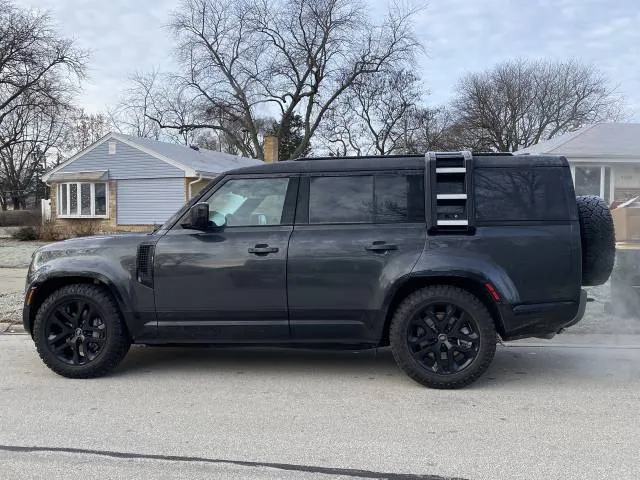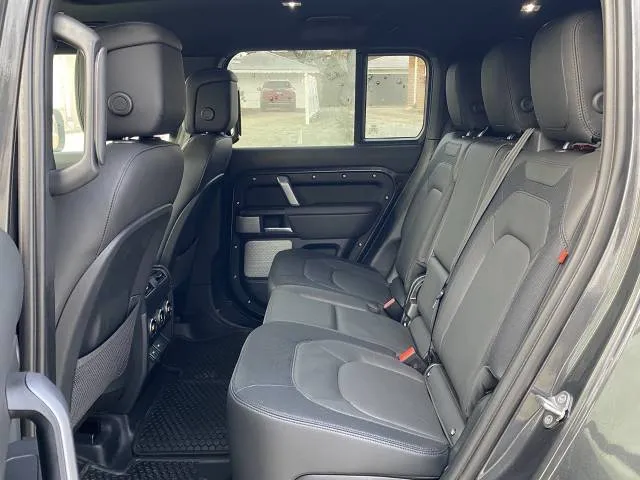The 2024 Land Rover Defender 130 Outbound arrived on my quiet suburban street like an apocalyptic military unit from M*A*S*H*: Terra Firma. With its extended wheelbase, roof ladder tucked on one side, and hard case that should’ve been a gas can slung on the other, and the full size spare with all-terrain tires studded from the tailgate, this overlanding luxury beast stood out for all the wrong reasons.
Even the name of its black coat, Carpathian Grey ($600), was conspicuous. An off-road edition on the already off-road intended Defender was as much overkill as calling its conspicuousness ostentatious. Big, boxy, bold, and unmistakably Land Rover, the Defender 130 Outbound in my driveway had my neighbors suspecting my supposed drug running had now involved arms dealing.
Incrementally, it grew on me, like the Defender itself, which returned to the U.S. in 2020 after a 23-year break. It first arrived with the five-door Defender 110, then with the three-door Defender 90, and last year with the super-sized Defender 130 and its seating capacity of eight. After a week of winter driving around town and never once using it for its intended off-road purpose, I kinda fell in love with the 130 Outbound. Here’s why.

Con: The Defender 130 Outbound expands the boundaries of most garages
Even with the air suspension in its lowest setting, this beast wouldn’t fit in my garage due to the shark fin antenna on the roof. At 211.7 inches—or 17.5-feet—long with the spare tire, it’s nearly identical in length to the Cadillac Escalade but more than a foot shorter than the Chevrolet Suburban. It’s just about as wide as an Escalade, but at 77.6 inches tall, it’s nearly two inches taller. It’s a uniquely American kind of big.

Pro: The Defender 130 Outbound’s generous interior
Even though the Outbound seats only five and deletes the third-row option in favor of more cargo space, I had no problem sitting five adults, including a 6-foot-5 nephew. It felt like a better fit for the five of us than an Escalade with the second-row bench. The boxy cargo area allowed for 46.9 cubic feet of cargo space behind the rear seats, enough for several jumbo holiday suitcases, boxes of gifts, and bags of food. It made for a great sleigh to shuttle family around.
Pro: The Defender 130’s commanding driving position
Another benefit of its size is the commanding driving position. Riding on 20-inch wheels and with the air suspension defaulting to a ground clearance of 11.5 inches, the view out of the big rectangular windshield is excellent.

Pro: Defender 130 Outbound’s refined manners
The Outbound’s turbocharged 3.0-liter inline-6 didn’t strain with the cabin full, nor did the turbo hesitate off the line, thanks in part to its 48-volt mild hybrid system. It generates 395 hp and 406 lb-ft, and the 8-speed automatic is virtually unnoticeable in its shifts. It’s relatively quick, with a 0-60 mph time of 6.3 seconds, yet it can tow up to 8,201 pounds. Ramping up to cruising speed can penetrate the serenity of the cabin, but around town the engine noise remains remarkably distant. It handles with the listing you’d expect in a vehicle this size, but in turns all four wheels felt moored to the ground and it never felt bullied by wind gusts.
Con: Defender 130 Outbound’s poor fuel economy
No matter the electrified boost, a vehicle weighing 5,610 pounds and with the aerodynamics of a brick isn’t going to be efficient. The EPA rates the Defender 130 Outbound at 16 mpg city, 18 highway, 17 combined. That’s about the same as the 6.2-liter V-8 in the Escalade, but much lower than the 20/26/22 mpg combined rating of GM’s excellent 3.0-liter inline-6 turbodiesel.

Pro: The Defender 130’s riveting interior
The exposed bolts riveting the interior pieces, from the door panels to the console frame, stud the Defender more than the originals. With grab handles bookending the dash, and a wide tray below the Defender logo stamped over the passenger side, it evokes a rugged, minimalist vibe. Yet it has the modern touches, with a large but not overwhelming touchscreen over a gear lever and compact but clever climate control interface.

Pro and con: Land Rover’s multi-function climate dials
The Defender 130 showed off one of Land Rover’s neatest interior functions: the two climate dials also adjust fan speed, temperature, and heated and cooled seating functions. It can be confusing at first, as pushing the digital dial changes the function from temperature to seat heating. Alternatively, a fan button next to the passenger dial needs to be pressed to adjust the fan speed for both sides. It’s a clever way to conserve space, and to not overwhelm the dash with buttons or stuff every function in the touchscreen. No other automaker does it.
It’s less successful for the drive modes. Pressing the drive mode button turns the driver side climate dial into drive modes. Maybe I would get used to it over time, but the logic gap never narrowed in my week with it.
Con: Overindulgent Defender 130 options
The $810 Comfort and Convenience Pack comes with a refrigerated center console. Land Rover throws in some cabin lighting, too. There were a handful of other small optional items I couldn’t discern, like black lug nut covers for $570.
The exterior ladder and case over either C-pillar were standard, but shouldn’t the Outbound model come with the electronic active differential? It was a $1,250 Off-Road Pack option.

Pro and con: Spend up for the Defender 130’s Premium Upgrade Interior Pack
One welcome option was the Premium Upgrade Interior Pack ($1,400). The 18-way front seats with heating, cooling, and memory settings turn that commanding view into a throne of comfort. The package wraps the steering wheel in leather. These features should probably be standard at this price, but the package is worth the spare change.
Pro: Jaguar Land Rover finally has a responsive infotainment system
Consider the course corrected. With Pivi Pro and an 11.4-inch touchscreen, JLR has greatly improved the responsiveness and functionality of its infotainment system. It fits within the compartmentalized dash, too, instead of dominating it like so many other modern luxury cars. It was dependable enough for me to native navigation instead of phone pairing.
Pro: Land Rover prices the Defender 130 Outbound right
It’s tough for me to admit an $85,975 SUV is priced right, but everyone I asked assumed it was a six-figure SUV. It’s luxurious and rugged, capable and calm, and it doesn’t feel as large as it is behind the wheel. Many try to emulate the Defender, but this new take on an old classic stands on its own.
_______________________________________
2024 Land Rover Defender 130 Outbound
Base price: $85,975, including $1,475 destination
Price as tested: $95,938
Drivetrain: Turbocharged 3.0-liter inline-6 with a mild-hybrid system, 8-speed automatic, AWD
EPA fuel economy: 16/18/17 mpg
Pros: Rugged interior, responsive infotainment, reasonably priced, drives smaller than it is
Cons: Silly and expensive options, unusual drive mode dial, so big, poor mpg
